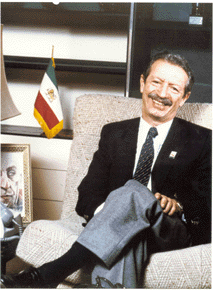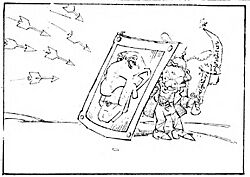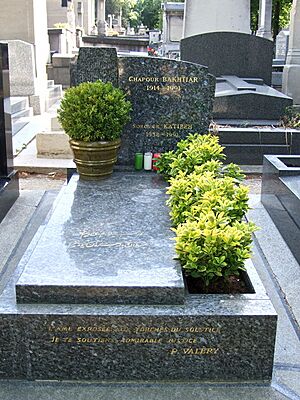Shapour Bakhtiar facts for kids
Quick facts for kids
Shapour Bakhtiar
|
|
|---|---|
|
شاپور بختیار
|
|

Bakhtiar in 1978
|
|
| 40th Prime Minister of Iran | |
| In office 6 January 1979 – 11 February 1979 |
|
| Monarch | Mohammad Reza Pahlavi |
| Preceded by | Gholam Reza Azhari |
| Succeeded by | Mehdi Bazargan (Acting) |
| Minister of Interior | |
| In office 16 January 1979 – 11 February 1979 |
|
| Prime Minister | Himself |
| Preceded by | Abbas Gharabaghi |
| Succeeded by | Ahmad Sayyed Javadi |
| Deputy Minister of Labor | |
| In office 1 July 1952 – 9 April 1953 |
|
| Monarch | Mohammad-Reza Pahlavi |
| Prime Minister | Mohammad Mossadegh |
| Member of Regency Council | |
| In office 13 January 1979 – 22 January 1979 |
|
| Appointed by | Mohammad Reza Pahlavi |
| Personal details | |
| Born | 26 June 1914 Shahrekord, Sublime State of Persia |
| Died | 6 August 1991 (aged 77) Suresnes, France |
| Cause of death | Assassination (stab wounds) |
| Resting place | Montparnasse Cemetery, Paris |
| Nationality | Iranian |
| Political party |
|
| Other political affiliations |
National Front (1949–1979) |
| Spouses | Madeleine Shahintaj |
| Children | 4 |
| Alma mater | Faculty of Law of Paris |
| Signature |  |
| Military service | |
| Allegiance | |
| Branch/service | French Army |
| Years of service | 1940–1941 |
| Unit | 30th Artillerie Regiment |
| Battles/wars | World War II |
Shapour Bakhtiar (born 26 June 1914, died 6 August 1991) was an important Iranian politician. He served as the very last Prime Minister of Iran under the rule of Mohammad Reza Pahlavi, who was the Shah (king) of Iran.
Bakhtiar believed strongly in democracy and warned against leaders who would rule with total power. He was sadly murdered in his home in France in 1991. This happened because of his political views and actions against the new government in Iran.
Contents
Early Life and Family Background
Shapour Bakhtiar was born on 26 June 1914 in southwestern Iran. He came from a powerful family of tribal leaders called the Bakhtiari tribe. His grandfather, Najaf-Gholi Khan Samsam ol-Saltaneh, had even been Prime Minister of Iran twice!
When Shapour was seven, his mother passed away. Later, in 1934, his father was executed by Reza Shah, who was the ruler of Iran at the time. This happened while Shapour was studying in Paris.
Education and Fighting for Freedom
Bakhtiar went to elementary school in Shahr-e Kord. He then attended secondary school in Isfahan and later in Beirut, where he finished high school at a French school. He studied at Beirut University for two years before moving to Paris for more university education.
In Paris, he studied law and political science. He was a strong opponent of any kind of unfair rule. He even volunteered to fight in the Spanish Civil War against a dictator named General Francisco Franco. In 1940, he joined the French army and fought in World War II. While living in France, he also joined the French Resistance, a group that fought against the German occupation during the war.
In 1945, he earned his PhD in political science. He also received degrees in law and philosophy from famous universities in Paris.
Political Career in Iran
After finishing his studies, Bakhtiar returned to Iran in 1946. He joined a political group called the Iran Party in 1949. He quickly became a leader in its youth section.
In 1951, he started working for the government. He became the director of the labor department in the Province of Isfahan. Later, he held the same job in Khuzestan, which is an important area for Iran's oil industry.
When Mohammad Mosaddeq became Prime Minister in 1951, Bakhtiar was appointed as his deputy minister of labor. However, after the Shah returned to power with help from other countries in 1953, Bakhtiar continued to speak out against the Shah's rule.

In the 1950s, Bakhtiar worked secretly against the Shah's government. He wanted elections to be fair and for the country to become more democratic. He was a key member of the National Front, a group that wanted to bring back democratic rights.
The Shah did not want to cooperate with these groups. He made the National Front illegal and put many liberal leaders, including Bakhtiar, in prison. Bakhtiar was jailed many times for a total of six years because he opposed the Shah.
At the end of 1978, the Shah's power was weakening. Bakhtiar was chosen to help form a new civilian government. The Shah appointed him Prime Minister as a way to calm the protests, especially from followers of Ayatollah Ruhollah Khomeini. Even though this decision led to him being removed from the National Front, Bakhtiar accepted the job. He was worried that a revolution would lead to communists or religious leaders taking over, which he believed would harm Iran.
During his 36 days as Prime Minister, Bakhtiar made several changes. He ordered all political prisoners to be freed and allowed newspapers to publish freely again. He also eased strict laws and ordered the secret police, called SAVAK, to be shut down. He asked the opposition for three months to hold elections and decide the future of Iran's government.
However, Khomeini refused to work with Bakhtiar. He called Bakhtiar a "traitor" and his government "illegitimate." Khomeini called for the Shah's rule to be overthrown. Bakhtiar's government was not supported by most people. The Shah was forced to leave Iran in January 1979. Bakhtiar himself left Iran for France in April of the same year.
Life in French Exile
After the revolution, a religious judge in Iran announced that Shapour Bakhtiar had been sentenced to death.
In July 1979, Bakhtiar appeared in Paris, France. He was given political asylum there, which means he was protected by the French government. From Paris, he led a group called the National Movement of Iranian Resistance. This group worked against the new Islamic Republic of Iran from outside the country.
In July 1980, Bakhtiar helped plan a coup attempt (a sudden takeover of the government) in Iran, known as the Nojeh coup plot. This made the Islamic Republic even more determined to carry out his death sentence.
On 18 July 1980, there was an attempt to kill him at his home in France. A policeman and a neighbor were killed, but Bakhtiar escaped. The group of five attackers, who were connected to the new Iranian government, were caught. They were sentenced to life in prison, but the French President later pardoned them in 1990. They were then sent back to Iran.
Death and Investigation

On 6 August 1991, Shapour Bakhtiar was murdered in his home in France. His secretary, Soroush Katibeh, was also killed. Both men were stabbed with kitchen knives. Their bodies were not found for more than a day and a half, even though Bakhtiar had police protection.
Two of the killers escaped to Iran. A third assassin, Ali Vakili Rad, was caught in Switzerland. He was sent to France for trial and sentenced to life in prison in 1994. However, he was released on parole in 2010 after serving 16 years. When he returned to Iran, he was welcomed as a hero by Iranian officials.
Some people believed that the French government might have been involved in Bakhtiar's death. However, there was no clear evidence to support these theories.
Published Works
Shapour Bakhtiar wrote a memoir and many articles. His books include Ma Fidélité (in French) and 37 Days after 37 Years (in Persian). These books tell about his life, his political career, and his beliefs. They are especially interesting for understanding Iranian society and politics during the time of the Shah and the revolution.
Personal Life
Shapour Bakhtiar was married twice. His first wife was a French woman, and they had three children: a son named Guy and two daughters, Viviane and France. Sadly, Viviane died of a heart attack in 1991. His son, Guy, became a French police intelligence officer.
Before his death, Bakhtiar married a young Iranian woman named Shahintaj. They had a son named Goudarz. He also had a stepdaughter named Manijeh Assad.
Shapour Bakhtiar is buried in Montparnasse Cemetery in Paris, France.
See also
- List of people involved with the French Resistance
Images for kids




